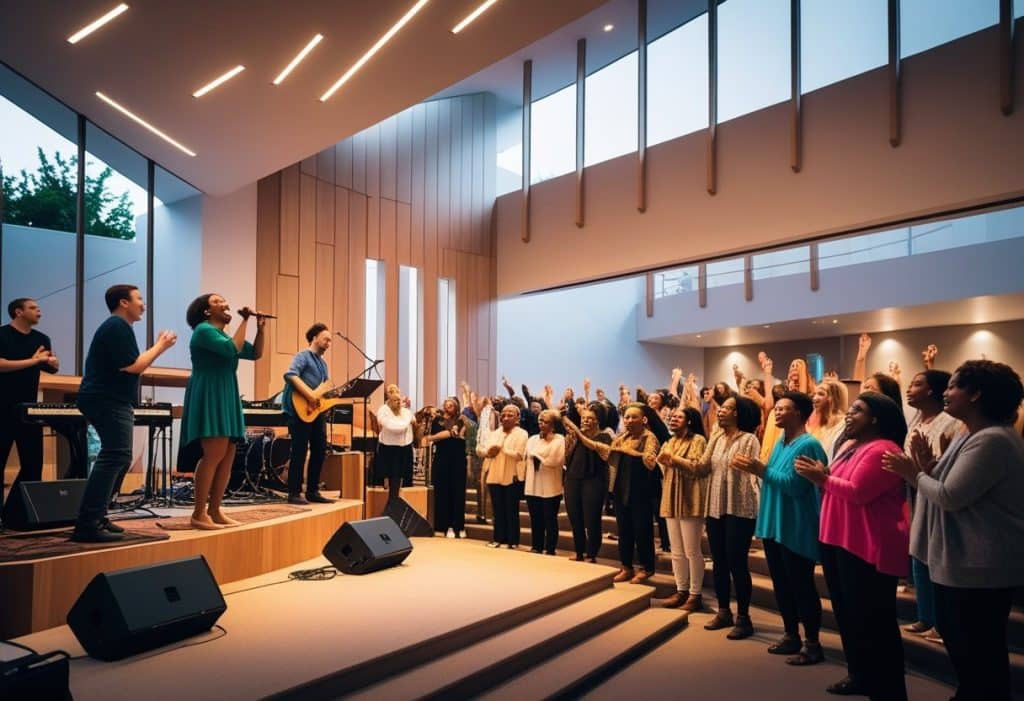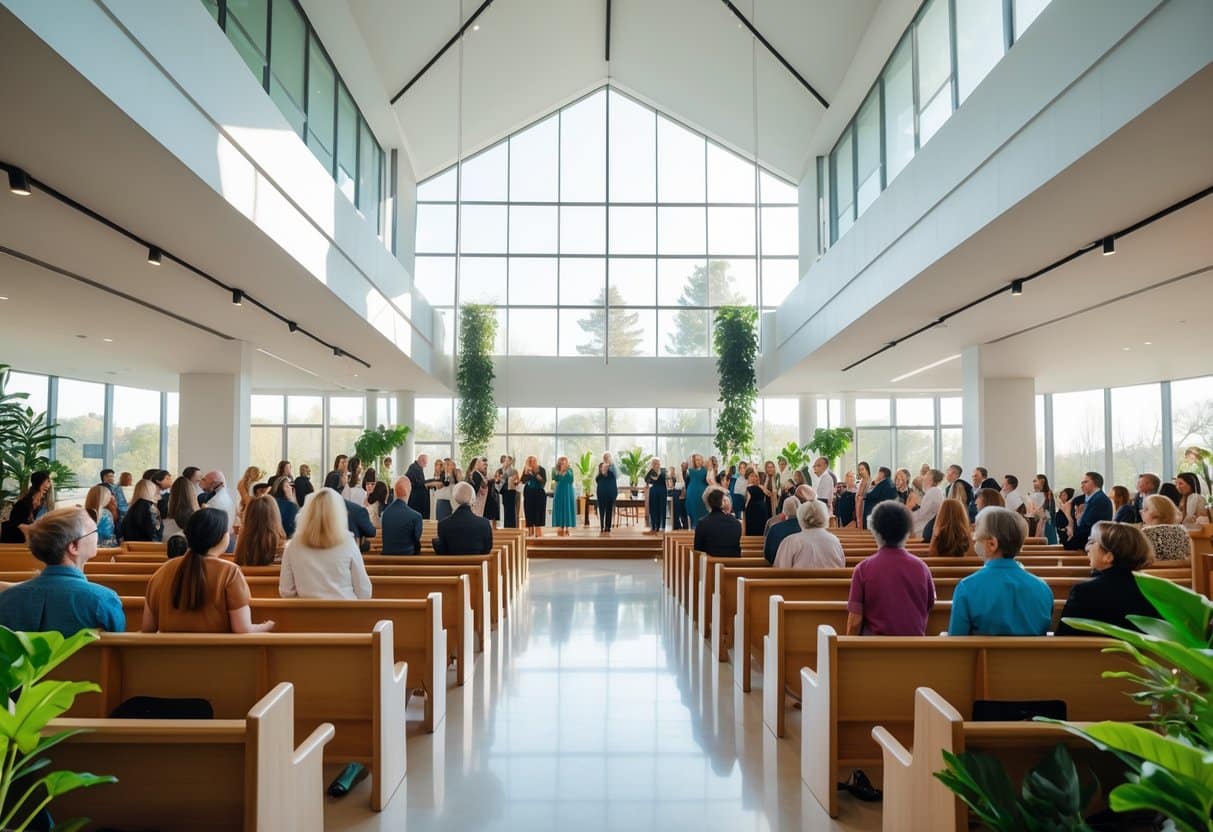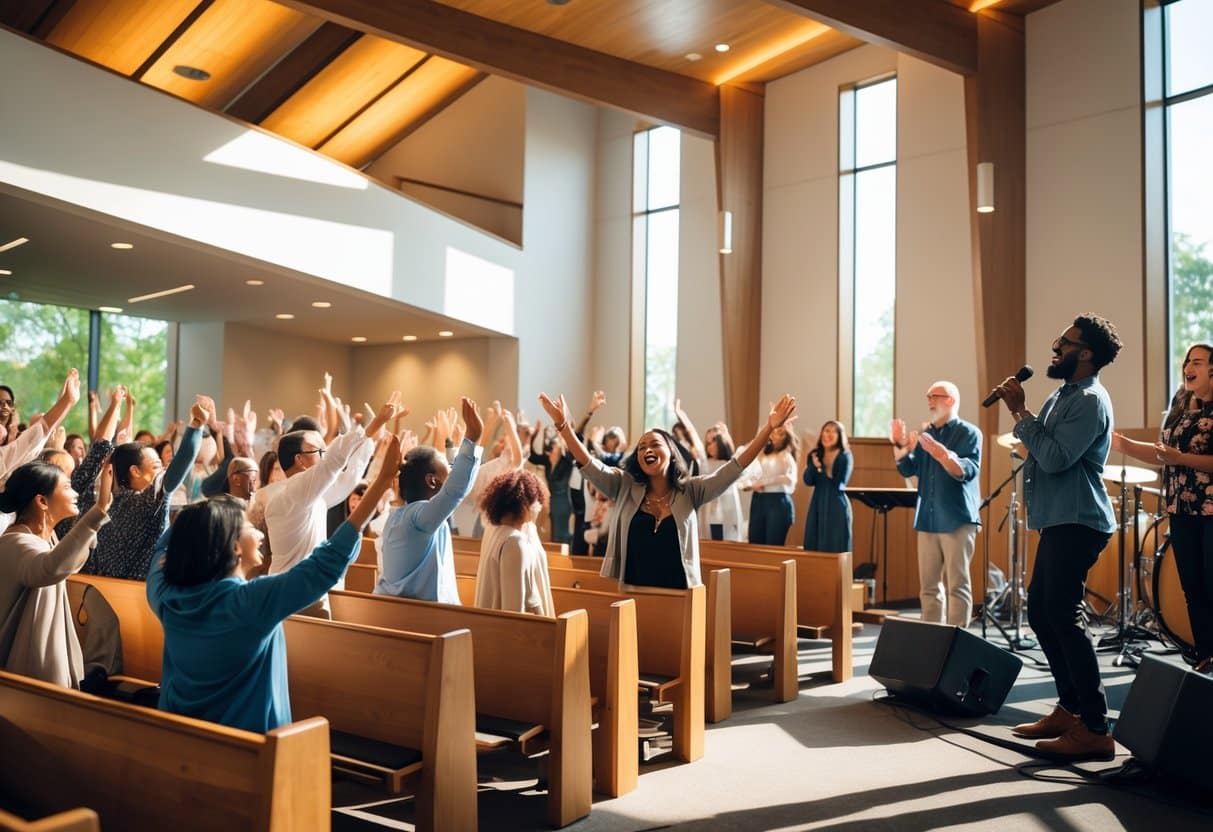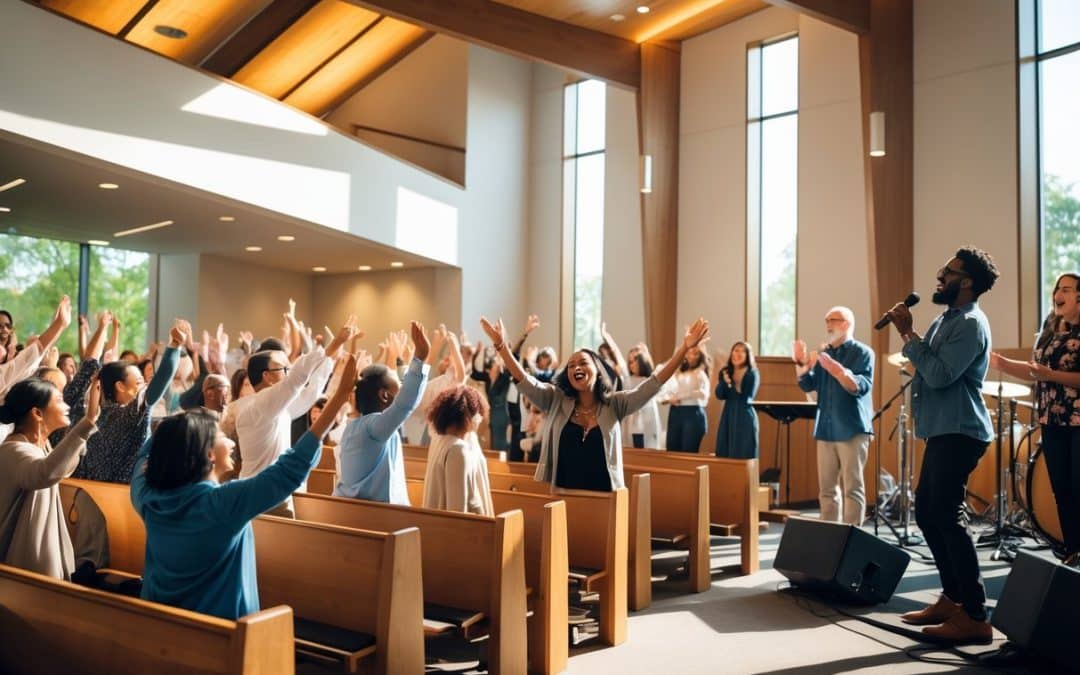Contemporary churches offer a fresh way to connect with faith that speaks to modern life. These churches blend traditional Christian beliefs with current styles of music, teaching methods, and community building. Many people find them more welcoming and easier to relate to than older church formats.

Contemporary churches excel at creating meaningful worship experiences through modern music, technology, and practical teachings that connect faith to everyday challenges. They often use current songs, interactive elements, and real-world examples to help people understand spiritual concepts. The atmosphere tends to be more casual and relaxed than traditional services.
These churches also focus strongly on building genuine relationships and serving their communities. Members often find it easier to make friends and get involved in helping others. The emphasis on personal growth and addressing real-life issues helps people apply their faith in practical ways throughout the week.
Key Takeaways
- Contemporary churches blend traditional Christian beliefs with modern worship styles and technology to create relevant faith experiences
- These churches emphasize building strong community connections and practical teachings that apply to everyday life
- Members benefit from personal growth opportunities and meaningful ways to serve their communities and address social issues
Defining a Contemporary Church

Contemporary churches focus on making worship accessible and relevant to today’s generation while staying true to core Christian beliefs. These modern churches use updated methods to connect with people in ways that feel natural and welcoming.
What Makes a Church Contemporary?
A contemporary church uses modern elements to create worship experiences that connect with today’s culture. Music plays a central role, featuring current styles with guitars, drums, and contemporary songs instead of traditional hymns.
Technology integration is common in these churches. They use projectors for song lyrics, multimedia presentations, and live streaming services. Sound systems are often more advanced to support modern musical arrangements.
The atmosphere tends to be casual and relaxed. People dress comfortably, and the environment feels less formal than traditional settings. Leaders often speak in conversational tones rather than formal sermon styles.
Contemporary churches emphasize accessibility. They remove barriers that might make newcomers feel uncomfortable or confused. Service elements are explained clearly, and church language is simplified for easy understanding.
Key Distinctions from Traditional Churches
Traditional churches typically follow established liturgies and centuries-old worship patterns. Contemporary churches adapt their format to current cultural preferences while maintaining biblical foundations.
Worship style represents the biggest difference. Traditional churches use organs, choir music, and formal hymns. Modern churches feature bands, contemporary Christian music, and participatory worship experiences.
Service structure varies significantly. Traditional worship follows set patterns with specific prayers and responses. Contemporary services flow more freely with flexible timing and spontaneous elements.
Communication approaches differ greatly. Traditional churches may use formal religious language and structured sermons. Contemporary churches use everyday language and interactive teaching methods that encourage questions and discussion.
Dress codes and expectations also contrast. Traditional settings often expect formal attire and specific behaviors. Contemporary churches welcome casual dress and relaxed participation styles.
Purpose and Vision of Modern Churches
Modern churches aim to make Christianity accessible to people who might feel disconnected from traditional religious settings. They focus on creating inclusive environments where everyone feels welcome regardless of background or experience level.
These churches prioritize community building through small groups, social activities, and volunteer opportunities. They emphasize relationships and personal connections rather than formal institutional structures.
Contemporary churches often emphasize practical faith application. They teach how Christian principles apply to daily life challenges like work, relationships, and personal growth. Sermons frequently address current social issues and modern concerns.
Evangelism takes different forms in modern churches. Instead of formal outreach programs, they focus on creating authentic community experiences that naturally attract newcomers. They use social media and digital platforms to connect with broader audiences.
Many contemporary churches blend traditional Christian values with innovative delivery methods. They maintain core biblical teachings while adapting presentation styles to reach today’s generation effectively.
Contemporary Worship Experience

Contemporary worship creates a unique blend of traditional faith and modern expression. Churches use current music styles, mix old hymns with new songs, and build welcoming spaces for all people.
Music Styles and Bands
Contemporary churches feature live bands instead of traditional organs or choirs. These bands use electric guitars, drums, keyboards, and modern sound systems.
Musicians play songs that sound like popular music styles. The melodies are easy to sing along with. Many songs repeat simple phrases that help people remember the words.
Common instruments include:
- Electric and acoustic guitars
- Full drum sets
- Keyboards and synthesizers
- Bass guitars
- Microphones for vocals
The band leaders guide the congregation through each song. They create an atmosphere where people feel comfortable participating. Some churches have professional musicians while others use volunteer members.
These music teams practice regularly to prepare for services. They choose songs that match the pastor’s message for each week.
Use of Hymns and Modern Songs
Churches blend old hymns with contemporary worship songs during services. This mix helps different generations connect with their spiritual journey together.
Traditional hymns bring deep theological meaning and rich history. Songs like “Amazing Grace” and “How Great Thou Art” have touched hearts for hundreds of years.
Modern songs use current language that people understand easily. They often focus on personal relationships with God. The lyrics are projected on screens so everyone can participate.
Popular mixing approaches:
- Playing hymns with modern instruments
- Using contemporary arrangements of old songs
- Alternating between hymn verses and modern choruses
Many worship leaders choose three to five songs per service. They create a flow that takes people through different emotions and thoughts about faith.
Atmosphere and Inclusivity
Contemporary churches work to create welcoming spaces for all types of people. The atmosphere feels relaxed and approachable rather than formal or intimidating.
People dress casually in jeans, t-shirts, or business clothes. There are no strict dress codes. Families with young children feel welcome to attend together.
The lighting and stage design help create a comfortable environment. Many churches use colored lights and visual displays during songs.
Key inclusive practices:
- Multiple service times to fit different schedules
- Child-friendly areas and activities
- Accessible seating and facilities
- Multilingual services when needed
Pastors and staff members greet visitors personally. They answer questions and help newcomers feel at home. The goal is making church feel like a community rather than a performance.
Contemporary worship encourages participation through clapping, raising hands, or simply listening quietly. People choose how they want to engage based on their comfort level.
Integration of Technology
Contemporary churches use digital tools to make worship more engaging and reach people beyond their physical walls. Modern technology helps churches share scripture and connect with members in new ways.
Digital Worship Tools
Contemporary churches use many digital tools to improve worship services. Presentation software displays song lyrics, scripture verses, and announcements on large screens. This helps everyone follow along easily.
Many churches use worship apps that let people access bulletins, take notes, and follow readings on their phones. These apps often include the day’s scripture passages and sermon outlines.
Sound systems and lighting create better worship experiences. Digital mixing boards help control audio levels. LED lighting can change colors to match different parts of the service.
Some churches use interactive prayer walls where people submit prayer requests digitally. Others have digital giving systems that make it easy to donate through phones or tablets.
Social media tools help churches share daily scripture verses and connect with members throughout the week. Many pastors use these platforms to share short messages and updates.
Live Streaming and Online Participation
Live streaming lets contemporary churches reach people who cannot attend in person. Members can watch services from home, work, or while traveling. This technology became very important during recent years.
Streaming platforms like YouTube, Facebook, and church websites make services available to anyone with internet access. Many churches see their online audience grow larger than their in-person attendance.
Interactive features during live streams let viewers participate. People can type prayer requests, ask questions, and share comments in real-time. Some churches have online chat moderators to help with questions.
Digital communion and baptism services help remote members participate in important church events. While different from in-person ceremonies, these options keep people connected to their faith community.
Recorded sermons and scripture studies stay available after services end. Members can rewatch messages, share them with friends, or catch up on missed weeks.
Accessible and Relevant Teachings
Contemporary churches focus on making biblical messages easy to understand and apply to daily life. Pastors use modern examples and engaging delivery methods to connect scripture with real-world situations that congregants face today.
Scripture-Based Practical Messages
Contemporary churches build their teachings around biblical truth while making it relevant to modern life. Pastors take passages from scripture and explain how they apply to current challenges like work stress, family problems, and personal relationships.
These messages address real questions people have about their faith journey. Instead of using complex theological language, pastors speak in simple terms that everyone can understand.
The goal is to help people see how Christianity fits into their everyday experiences. For example, a sermon about forgiveness might include practical steps for handling workplace conflicts or family disagreements.
Churches often provide study guides and discussion questions that help members dig deeper into the biblical principles. This approach helps people move beyond just hearing the message to actually living it out.
Many contemporary churches also use current events and popular culture references to illustrate biblical concepts. This makes the ancient wisdom of scripture feel fresh and applicable to modern situations.
Engaging Sermon Styles
Contemporary churches use dynamic presentation methods to keep audiences engaged throughout the service. Pastors often walk around instead of standing behind a podium, creating a more conversational atmosphere.
Visual aids like slides, videos, and interactive elements help illustrate key points. These tools make complex biblical concepts easier to grasp and remember.
Many pastors use storytelling techniques that connect with different age groups. They share personal experiences and real-life examples that help people relate to the message on an emotional level.
Question and answer sessions during or after sermons encourage active participation. Some churches even use technology like live polls or text messaging to get immediate feedback from the congregation.
The sermon length is often shorter than traditional churches, typically lasting 25-35 minutes. This keeps people focused and prevents information overload while still delivering meaningful biblical content.
Community and Connection
Contemporary churches create spaces where people from all walks of life can build meaningful relationships and support each other through life’s challenges. These communities focus on welcoming everyone and building connections that extend far beyond weekly worship services.
Openness and Inclusivity
Contemporary churches work hard to welcome people from different backgrounds and life experiences. They create environments where newcomers feel accepted regardless of where they are in their spiritual journey.
Many modern churches have moved away from strict dress codes and formal traditions. This helps people feel comfortable attending without worrying about fitting in perfectly.
Diverse worship styles appeal to different age groups and cultural backgrounds. Some churches offer multiple service options to meet various preferences.
These churches often address real-world issues that affect their community members. They talk openly about topics like mental health, financial struggles, and relationship challenges.
Staff and volunteers receive training on how to welcome visitors warmly. They learn to answer questions without making assumptions about someone’s faith journey or background knowledge.
Supportive Relationships
People in contemporary churches build genuine friendships that provide emotional and practical support during difficult times. Small groups and Bible studies create opportunities for deeper conversations beyond casual Sunday morning greetings.
Members often help each other with practical needs like:
- Moving assistance
- Meal preparation during illness
- Childcare support
- Job search networking
- Financial guidance
Prayer groups offer spiritual support for those facing health issues, family problems, or major life decisions. People can share personal struggles knowing they will receive compassion rather than judgment.
Mentorship programs connect experienced members with those newer to faith. These relationships help guide people through questions and challenges in their spiritual growth.
Fellowship Beyond Sunday Services
Contemporary churches organize activities throughout the week that bring people together in relaxed settings. These events help members connect over shared interests and common goals.
Community service projects allow people to work together while helping their neighborhoods. Food banks, park cleanups, and charity drives build teamwork and friendships.
Social events like game nights, potlucks, and movie screenings create fun ways for families to spend time together. These gatherings help children and teenagers form friendships with peers who share similar values.
Many churches host support groups for specific life situations. Grief counseling, parenting classes, and addiction recovery meetings provide specialized help within a caring community setting.
Personal Growth and Well-Being
Contemporary churches create spaces where people can grow personally and find better mental health. These communities offer support systems that help members develop spiritually while also taking care of their emotional needs.
Opportunities for Spiritual Growth
Contemporary churches make the spiritual journey more accessible to people at all stages of life. They use modern music, interactive discussions, and small group settings that help members connect with their faith.
Many churches offer programs that guide people through different phases of their faith journey. These might include Bible study groups, mentorship programs, and workshops on prayer and meditation.
The community aspect plays a big role in spiritual development. Members support each other through challenges and celebrate growth together. This creates a safe environment where people feel comfortable exploring their beliefs.
Contemporary church settings often encourage questions and open dialogue. This approach helps people develop a deeper understanding of their faith instead of just following rules.
Small groups within the church provide personal attention. Members can share struggles, ask for guidance, and learn from others who have faced similar situations.
Emotional and Mental Health Benefits
Regular church attendance provides strong social connections that boost mental health. Having a community of people who care creates a support network during difficult times.
Contemporary churches often address real-life issues like stress, anxiety, and relationship problems. They connect faith with practical solutions for everyday challenges.
Many churches offer counseling services or support groups for specific needs. These might include grief counseling, addiction recovery, or marriage support programs.
The sense of belonging that comes from church membership helps reduce feelings of loneliness. People develop friendships that extend beyond Sunday services.
Worship activities like singing and prayer can reduce stress levels. These practices help people find peace and perspective during busy or challenging weeks.
Churches also provide opportunities to serve others through volunteer work. Helping in the community gives people a sense of purpose and fulfillment that improves overall well-being.
Serving and Social Impact
Contemporary churches focus heavily on making real differences in their communities through hands-on service and outreach programs. These modern congregations create many ways for members to volunteer and help others in need.
Community Outreach Initiatives
Contemporary churches run food banks that serve hundreds of families each month. They organize clothing drives for homeless shelters and provide school supplies to kids who cannot afford them.
Many modern churches partner with local organizations to address bigger problems. They work with housing groups to build homes for low-income families. Some churches start after-school programs that help students with homework and provide safe places to stay.
Mental health support has become a key focus. Churches offer counseling services and support groups for people dealing with depression, anxiety, and addiction. They train volunteers to recognize mental health warning signs.
Popular outreach programs include:
- Free community meals
- Job training workshops
- English language classes
- Senior citizen care visits
- Youth mentorship programs
These initiatives help churches connect with people who might not normally attend services. The programs show faith in action rather than just words.
Opportunities for Volunteering
Modern churches create volunteer roles that match different skills and interests. People can help with children’s programs, serve meals, or assist with building repairs.
Technology-focused volunteers help churches reach more people online. They manage websites, create social media content, and run live streams of services.
Common volunteer positions:
- Food pantry workers
- Youth group leaders
- Event coordinators
- Musicians and sound technicians
- Administrative helpers
Contemporary churches make volunteering flexible for busy schedules. They offer short-term projects alongside long-term commitments. Some churches organize volunteer days where families can serve together.
Many churches connect volunteers with community organizations outside the church walls. This helps members find causes they care about most while representing their faith values in the wider community.

